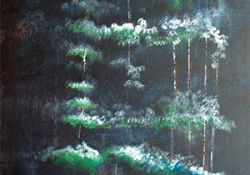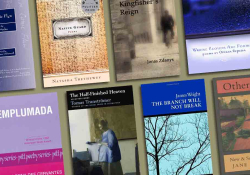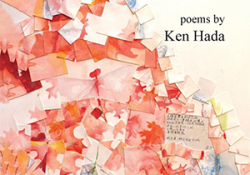The River White: A Confluence of Brush and Quill by Ken Hada
Duane Hada, ill. Norman, Oklahoma. Mongrel Empire. 2011. ISBN 9780983305262
 Brothers Duane and Ken Hada have produced an unusual and unusually beautiful book, which traces the White River, from its origins in northwestern Arkansas south to where it joins the Arkansas River, just before it flows into the Mississippi. Duane Hada’s watercolors on each page arrest the reader’s attention at different locations, creating a pictorial narrative; Ken Hada’s short poems facing the illustrations remind us that the best travelers perceive and think sideways, fusing what is before them with memories and associations.
Brothers Duane and Ken Hada have produced an unusual and unusually beautiful book, which traces the White River, from its origins in northwestern Arkansas south to where it joins the Arkansas River, just before it flows into the Mississippi. Duane Hada’s watercolors on each page arrest the reader’s attention at different locations, creating a pictorial narrative; Ken Hada’s short poems facing the illustrations remind us that the best travelers perceive and think sideways, fusing what is before them with memories and associations.
To be true to the nature of the river as it presently exists, Duane Hada doesn’t look away from the human structures that mark various locations, such as Bull Shoals Dam, the floating house at DeValls Bluff, or the bridges at Clarendon. The value of certain places for Ken Hada, too, lies in the presence of humanity along the river: the town of Calico Rock, which held “mysterious sway” over the brothers as boys; at one point, “the lucky ones / tie john boats / to a fading red / dock. . . .” While very much in evidence, however, the human form is quite spectral in the watercolors, compared to the sharper close-ups of birds, fish, and deer. A red canoe in the middle distance, a silhouette of a fisherman against the water, a small vertical brushstroke against the flat blue-gray of the river: they are there, but what looms and glows behind them and in front of them is more. They are the spots to catch the eye before the eye widens to the reality of the scene. The poems, on the other hand, register the human consciousness, seeing and meditating. Two green mounds or mountains humped beside the river at Cartney summon memory of the Psalmist: “On some days goodness / and mercy are not / merely abstractions.” At that point, the speaker becomes his feet, in gravel, a crawdad scooting away, while he waits for paradise to come to him.
Not that paradise comes to the reader from that poem, nor even from the green mounds and blue water that face it; it’s an instance of what often happens in The River White, where the poems and pictures build on one another. The reader is brought into the world, into the journey, to discover what the poet means or wants to mean. For me, at least, “paradise” occurs before, in the hazy, impressionistic green-blue-gold pictures on pages 24 and 26; the best human responses are Edenic and after: assertion of voice, dominion, balanced with a bit of guilt—“I feel I should apologize”; the solitary “I noticed today,” balanced with the need for someone “to go with me far enough,” even to the end, where we leave the river in autumn, with the final image of a gold sycamore leaf sinking toward the stone bottom, facing a diminished memory shot of the green waterfall that began our journey.
The River is a calming and meditative book that gains momentum even as the river itself slows, increasingly crossed and elbowed by human structures, spreading into wetlands, before joining the Great River itself.
W. M. Hagen
Oklahoma Baptist University




